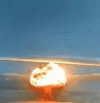You may have never heard of them. They were actually the first reactors built in the late 1940's thru mid 1950's. Two of these working reactors were built and ran a long time. Very safe designs. They can use existing spent nuclear waste as fuel. A lot of people like James Hansen of NOAA and from Iowa say these types of reactors need to be used to create most of the energy we use and to replace carbon fuels.
Three Mile Island, Chernobyl, Fukashima are liquid water reactors LWRs, like all the other commercial and military reactors in the world, that boil steam to get extreme temps and extreme pressures inside the reactor. Lose your electricity and you are unable to cool the reactor, hydrogen gas is created at high temps and pressures, and WHAM explosion inside the containment dome.
Many countries are working on what are called 3rd and 4th generation which use the old technology of molten salts etc to carry the fuel, carry away heat to boil water in another building with the generator, the the salt is also the coolant.
Molten salt reactors operate at high temperatures but the molten salts are liquids at basically atmospheric temperatures.
A "molten salt reactor" search in Wikipedia is a great read if you are interested and describes most of the current 21st Century projects in various countries. I believe China and Russia are just getting ready to bring a few of them online (of course those countries do not have the permitting and design regulations the US and other countries have).
PBS Nova "The Nuclear Option" is a very good 1 hour episode if you can access it on the history of molten salt reactors, how they work, and why they are safer.
Three Mile Island, Chernobyl, Fukashima are liquid water reactors LWRs, like all the other commercial and military reactors in the world, that boil steam to get extreme temps and extreme pressures inside the reactor. Lose your electricity and you are unable to cool the reactor, hydrogen gas is created at high temps and pressures, and WHAM explosion inside the containment dome.
Many countries are working on what are called 3rd and 4th generation which use the old technology of molten salts etc to carry the fuel, carry away heat to boil water in another building with the generator, the the salt is also the coolant.
Molten salt reactors operate at high temperatures but the molten salts are liquids at basically atmospheric temperatures.
A "molten salt reactor" search in Wikipedia is a great read if you are interested and describes most of the current 21st Century projects in various countries. I believe China and Russia are just getting ready to bring a few of them online (of course those countries do not have the permitting and design regulations the US and other countries have).
PBS Nova "The Nuclear Option" is a very good 1 hour episode if you can access it on the history of molten salt reactors, how they work, and why they are safer.

